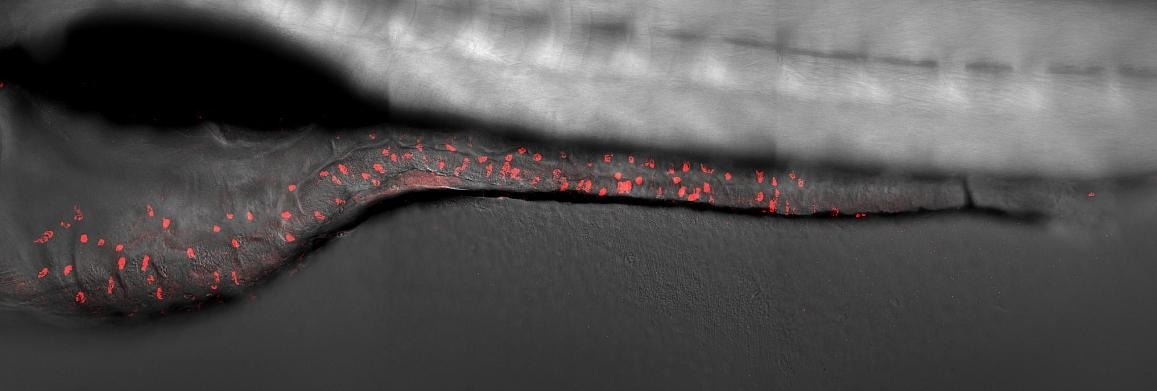Scientists from the National Institutes of Health have released a comprehensive guide to the development of zebrafish, outlining the gene expression patterns activated in almost every cell type during the initial five days of growth.
 BEST4+ cells are labeled red along the zebrafish gastrointestinal tract. These understudied cells are linked to gastrointestinal diseases and cancer in people. Image Credit: National Institute of Child Health and Human Development.
BEST4+ cells are labeled red along the zebrafish gastrointestinal tract. These understudied cells are linked to gastrointestinal diseases and cancer in people. Image Credit: National Institute of Child Health and Human Development.
This crucial timeframe witnesses the transformation of embryos from a singular cell into specific cell types, eventually giving rise to a variety of cells that develop into tissues and organs, ultimately forming juvenile fish with the ability to swim and forage for food. The results of their research have been published in Developmental Cell.
Perhaps surprisingly, tiny zebrafish provide us with significant insight into human development and disease. Many of the gene expression programs that direct embryonic growth are similar across fish, people, and other animals.”
Christopher McBain, Scientific Director, Eunice Kennedy Shriver, National Institute of Child Health and Human Development
McBain added, “Since zebrafish are visibly transparent, fertilize eggs externally, and are easy to study genetically, they represent a unique and effective way to model human disease.”
The orchestration of embryonic development relies on DNA instructions that guide distinct programs of gene expression within individual cells, determining the unique functional characteristics of various cell types.
To construct the atlas, the research team employed single-cell RNA sequencing, a method that identified gene expression programs throughout a five-day period, with samples collected at intervals ranging from two to 12 hours.
The resulting atlas meticulously tracks almost 490,000 cells continuously over 120 hours post-fertilization, revealing an average of 8,621 transcripts and 1,745 genes detected per cell. Subsequently, the research team categorized this data according to known cell types and developmental cell states.
Emphasizing the practicality of the atlas, the research team concentrated on the study of less-explored cells, particularly BEST4+ intestinal cells associated with gastrointestinal diseases and cancer in humans.
Due to their absence in prevalent model organisms like mice, there is limited knowledge about the developmental processes of these cells.
Utilizing the atlas, the team computationally anticipated the comprehensive developmental program of BEST4+ cells, identifying the signals initiating their development and the transcription factors executing the process. These insights can be assessed in model organisms or clinical samples, enhancing our comprehension of the role of BEST4+ cells in human disease.
Our atlas on early zebrafish development is an extremely thorough resource that describes the expression program of hundreds of cell types across 62 developmental stages.”
Jeffrey A. Farrell, Study Senior Author, Earl Stadtman Investigator and Head, Unit on Cell Specification and Differentiation, National Institute of Child Health and Human Development
Farrell added, “From this atlas, we made discoveries about understudied cells, including intestinal cells involved in human diseases, smooth muscle that surrounds the intestine, and cells that surround blood vessels. There are many more advances waiting to be uncovered, and we look forward to seeing what the research community can do with our open-source atlas.”
Source:
Journal reference:
Sur, A., et al. (2023) Single-cell analysis of shared signatures and transcriptional diversity during zebrafish development. Developmental Cell. doi.org/10.1016/j.devcel.2023.11.001.